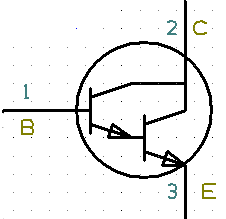
It was probably 40 years ago that I learned about something called a Darlington transistor. Outside, it looked like an ordinary transistor, but inside, there were actually two transistors stacked in such a way that the “output” of one fed into the “input” of the next one. So if a normal transistor amplifies current by a factor of 100, a Darlington would theoretically amplify by a factor of 100 x 100 = 10,000! What a bargain, to be able to control 10 amps with just 1 milliamp! It seemed strange that people didn’t use these wonder transistors to switch heavy loads all the time, but never really thought about it.
Recently, I realized the trouble with Darlingtons. In order for the transistor on the right to turn on, it needs (say) 0.7 volts on its base. That can only come from the transistor on the left, which, even if saturated at 0 volts (yeah, like that’s ever going to happen) from collector to emitter, will then have 0.7 volts on its collector. But wait, the two transistors have collectors tied together, so that means the whole Darlington has a saturation voltage of 0.7 volts. In real life, it’s actually more, like a volt or more. This is a problem, because it means that if 10 amps is flowing, the transistor will be dissipating 10 watts or more. That’s like a low-power soldering iron. Besides being inefficient, a heat sink would be required. Contrast that to a power MOSFET, which might pass 10 amps and dissipate half a watt.
But I’ve found an application where a Darlington is the perfect thing. Just like people, everybody’s good at something. I’ll fill you in on the application on my other blog.